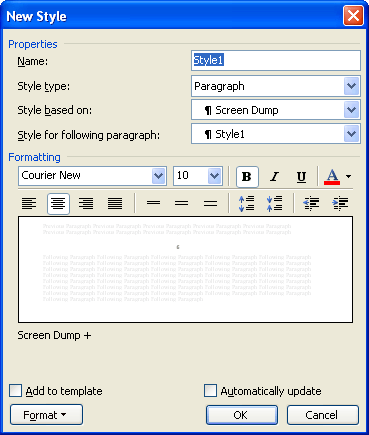Please Note: This article is written for users of the following Microsoft Word versions: 97, 2000, 2002, and 2003. If you are using a later version (Word 2007 or later), this tip may not work for you. For a version of this tip written specifically for later versions of Word, click here: Defining Styles.
Written by Allen Wyatt (last updated December 27, 2018)
This tip applies to Word 97, 2000, 2002, and 2003
Styles are key to the underlying power of Word. They allow you to consistently define how your text should look throughout a document or a series of documents. There are a number of ways in which you can define styles, but the way you use will depend most heavily on the version of Word you are using. To define a style using Word 97 and Word 2000, simply follow these steps:
Both Word 2002 and Word 2003 use a task pane in their user interface, which means that there are some differences in how you define styles:

Figure 1. The New Style dialog box.
Once the style is defined (or an existing style modified), you can use your style anywhere you like within your document.
WordTips is your source for cost-effective Microsoft Word training. (Microsoft Word is the most popular word processing software in the world.) This tip (591) applies to Microsoft Word 97, 2000, 2002, and 2003. You can find a version of this tip for the ribbon interface of Word (Word 2007 and later) here: Defining Styles.

Learning Made Easy! Quickly teach yourself how to format, publish, and share your content using Word 2021 or Microsoft 365. With Step by Step, you set the pace, building and practicing the skills you need, just when you need them! Check out Microsoft Word Step by Step today!
Have you ever made one formatting change in your document, only to see that change applied to all the paragraphs in the ...
Discover MoreNeed to get rid of direct, explicit formatting applied to a document? Here's an easy way to do it using familiar Word tools.
Discover MoreUsing the Styles and Formatting task pane, Word allows you to select all instances of a given style in your document. ...
Discover MoreFREE SERVICE: Get tips like this every week in WordTips, a free productivity newsletter. Enter your address and click "Subscribe."
2016-11-02 09:38:09
kasi
did not help
2015-10-26 14:23:47
daijon
tht do not help
Got a version of Word that uses the menu interface (Word 97, Word 2000, Word 2002, or Word 2003)? This site is for you! If you use a later version of Word, visit our WordTips site focusing on the ribbon interface.
Visit the WordTips channel on YouTube
FREE SERVICE: Get tips like this every week in WordTips, a free productivity newsletter. Enter your address and click "Subscribe."
Copyright © 2025 Sharon Parq Associates, Inc.
Comments